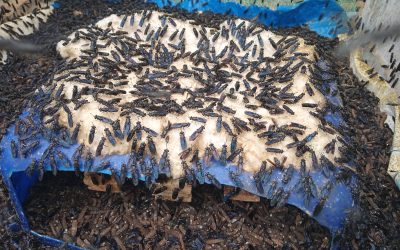Fall armyworm

Fall Armyworm
Understanding the Fall Armyworm
What are Fall Armyworms?
Fall Armyworms are larvae in the growth stage of moths that attack various crops, causing significant losses to farmers. Fall Armyworms (Spodoptera frugiperda) originated in tropical areas of the Americas (Argentina and the Caribbean).
They were first detected in Africa in 2016 and began to appear in countries such as Benin, Nigeria, Sao Tome and Principe, and Togo (FAO).
By January 30, 2018, Fall Armyworms had been reported in almost all countries south of the Sahara Desert except Djibouti, Eritrea, and Lesotho (FAO).
In Uganda, they were first observed in 2017 in the districts of Kasese and Bukedea and have since spread to more than 15 districts.
There are two types of armyworms: Fall Armyworms (Spodoptera frugiperda) and African Armyworms (Spodoptera exempta). Both are destructive to crops but differ in their origins and some feeding habits.
Armyworms attack over 80 types of crops, with a preference for grains such as maize, sorghum, millet, rice, barley, wheat, and sugarcane, as well as vegetable crops.
In 2019, Fall Armyworms were reported in the Luweero and Mbale districts of Uganda. Since these pests spread rapidly, farmers were advised in nearby districts to take precautions.
Life Cycle of Fall Armyworms
Fall Armyworm moths lay many eggs, which hatch after 3-5 days. The larvae (caterpillars) emerge and live for 14-28 days. From the larval stage, pupae form and last for 7-14 days. The adult moth emerges from the pupa, living for an average of 14 days.
The moth can fly up to 100 kilometers per day, covering up to 2000 kilometers in its lifetime.
A female moth can lay up to 2000 eggs in her lifetime.
The larva (caterpillar) is the stage that attacks plants and lasts for 14-28 days.
A female moth can have 6-12 generations per season.
Identifying Fall Armyworms
Fall Armyworms can be identified by the following characteristics:
Eggs are laid in clusters of 100-300.
Eggs are covered with a white cottony substance.
Eggs are laid under the plant’s leaves.
Eggs hatch after 3-5 days.
The moths emerge and fly only at night.
The wings of male moths have three white triangular marks at the corners and in the middle.
The wings of female moths are entirely brown with spots.
The larva has a “Y” mark on its head.
The larva has four square-shaped dots on the eighth segment from the head.
Signs of Fall Armyworm Infestation
Infestations of Fall Armyworms are identified through their growth stages:
First stage: Caterpillars eat one side of the leaf.
Second and third stages: Caterpillars create holes in the leaves.
Fourth to sixth stages: Caterpillars consume entire leaves.
Sometimes they bore into corn cobs, attack grains, hide in corn husks, and also attack tassels.
Effects of Fall Armyworms on Plants
They attack leaves, causing the plant to grow poorly.
They attack stems, causing the plant to collapse and die.
The use of pesticides to control them can cause health problems through contaminated crops (Phytotoxicity).
They attack tassels, leading to poor pollination.
They attack grains, resulting in poor yields and reduced grain quality.
Economic Impact of Fall Armyworms
The invasion of these pests causes significant economic losses to communities and the nation as a whole, including:
Increased production costs due to the purchase of pesticides.
They can destroy entire fields, forcing farmers to replant.
Governments may allocate large budgets for pest control programs.
They can cause famine and ultimately poverty for farmers and possibly the nation as a whole.
The use of pesticides to control these pests causes environmental damage, leading to additional costs to maintain the environment.
When to Use Pesticides for Fall Armyworms
Armyworm infestations can be prevented only if pesticides are used correctly and at the right time. When using pesticides, consider the following:
Use right pesticides
Mix water and pesticides correctly (read the label or ask an extension officer in your area).
Control larvae when they are still small before they hide.
Avoid mixing more than one pesticide in one pump.
Use protective gear when spraying.
For additional recommendations for pestcides call or WhatsApp 0781545408
